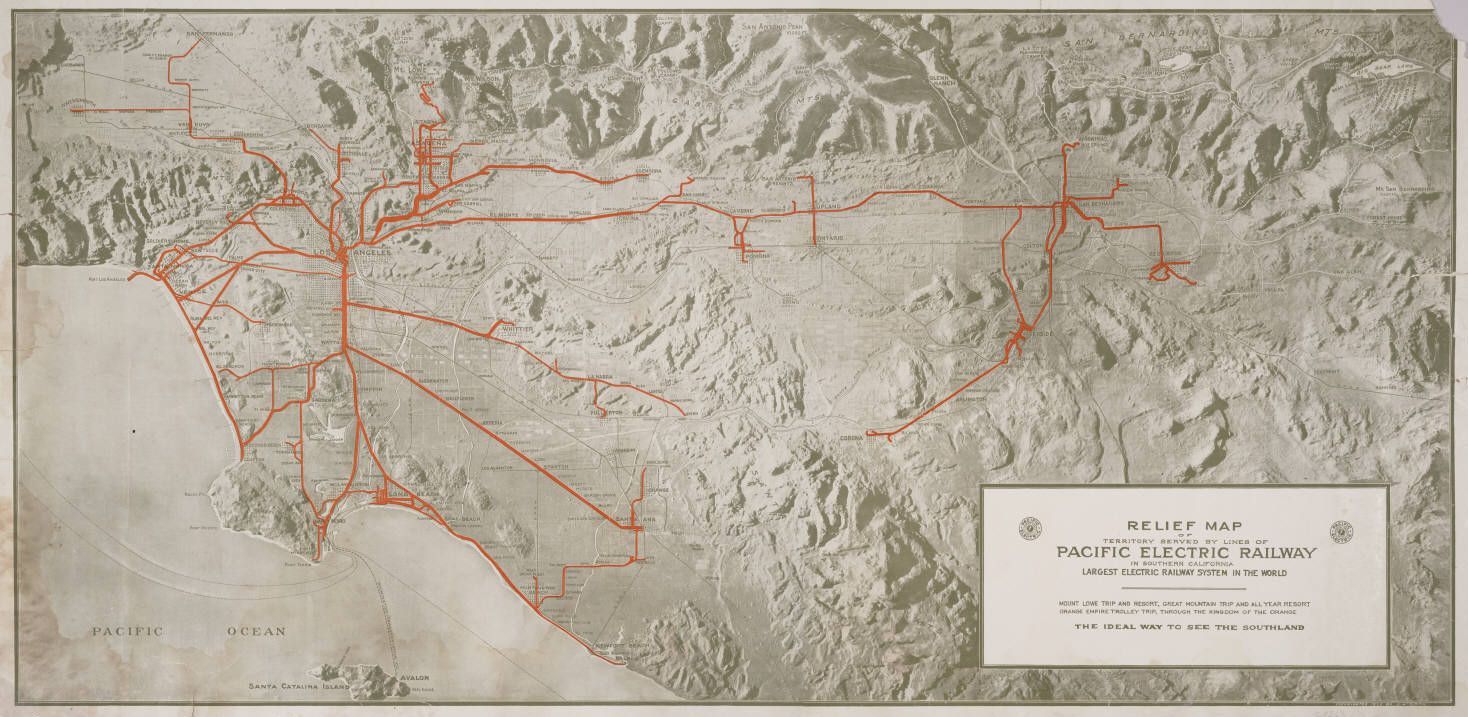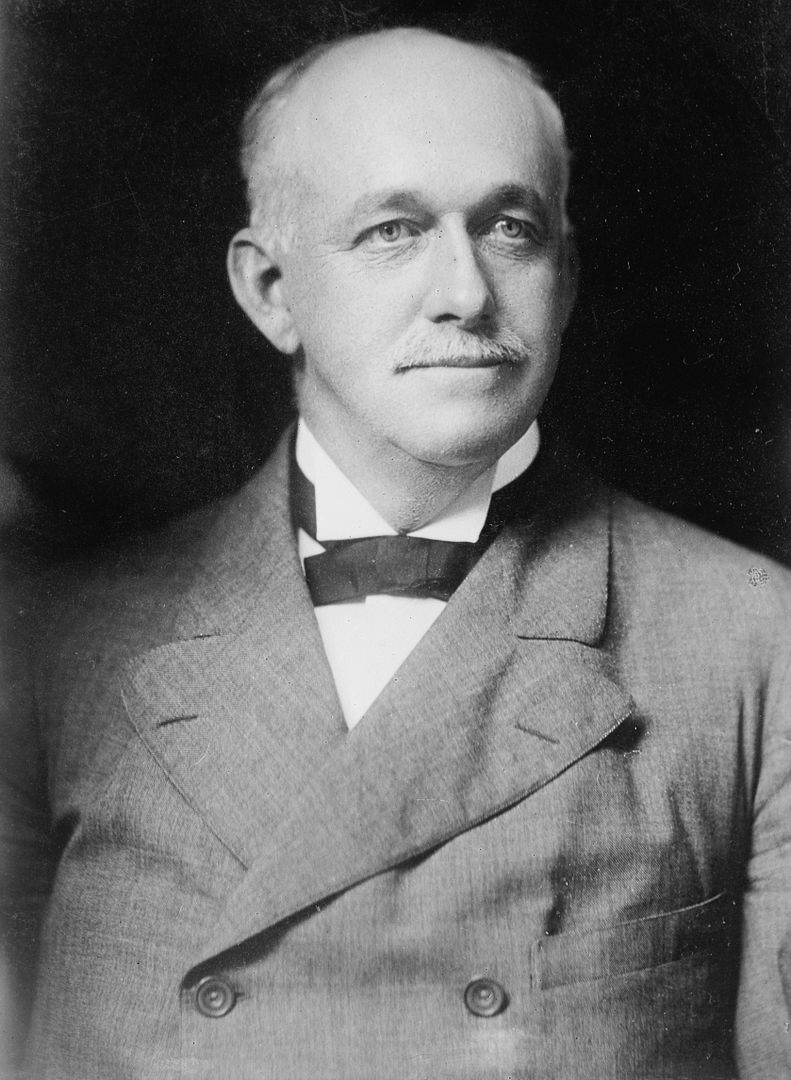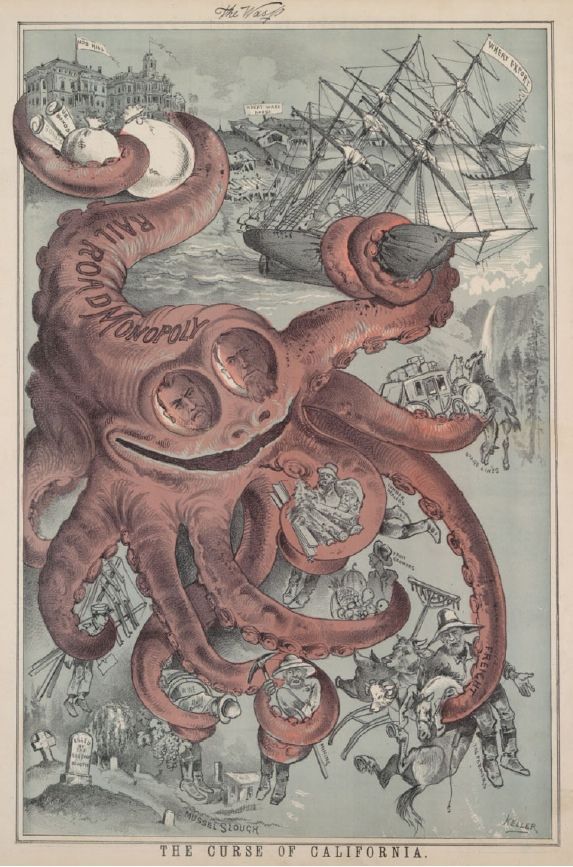When Eric Molinsky lived in Los Angeles, he kept hearing this story about a bygone transportation system called the Red Car. The Red Car, he was told, had been this amazing network of streetcars that connected the city—until a car company bought it, dismantled it, and forced a dependency on freeways.
If this sounds familiar, it might be because it was the evil scheme revealed at the end of Robert Zemeckis’s 1988 movie, “Who Framed Roger Rabbit.”
But like most legends, the one that Eric heard about the Red Car is not entirely accurate. It’s true that Los Angeles did have an extensive mass transit system called the Red Car, which at one time ran on 1,100 miles of track — about 25 percent more track mileage than New York City has today, a century later.
But the Red Car wasn’t the victim of a conspiracy. The Red Car was the conspiracy.
Our reporter Eric Molinsky spoke with historian Bill Friedricks, who says that to understand the Red Car, you first need to know about Henry Huntington, one of the major power brokers of Los Angeles. If you’ve ever heard of Huntington Beach, Huntington Park, or the Huntington Library, this is that Huntington.
Henry Huntington was the nephew of railroad magnate Collis Huntington, who mentored Henry and taught him the family business. When Collis Huntington died in 1900, Henry expected that he would inherit his uncle’s company, Southern Pacific. But Southern Pacific’s board didn’t want another Huntington in charge. They forced him out but gave him a $15 million payout (about $400 million today).
Henry Huntington took his money and headed for Los Angeles. He purchased the biggest transportation system in the city, the Los Angeles Railway (LARy), and then incorporated it into a new company called Pacific Electric. Huntington also started building hundreds of subdivisions on the periphery of Los Angeles and used Pacific Electric trains—bright red trolleys—to connect the subdivisions to downtown Los Angeles.
Over time, though, Huntington had built so many subdivisions that his Red Car couldn’t do a good enough job connecting the city’s disparate areas. The Red Car was never designed to be a comprehensive system like the New York City Subway; rather, it existed primarily to get people in and out of Huntington’s subdivisions. Angelenos who could afford cars found it was easier to get around by driving. The Red Car fell into disrepair, and was mocked as a “slum on wheels.”
Eventually, Southern Pacific (the company Huntington thought he would inherit from his uncle Hollis) bought Pacific Electric, and in 1926 they offered Los Angles a massive plan to use public dollars to build subways and elevated trains around downtown L.A. But California voters didn’t trust Southern Pacific, which had meddled in California politics for so long that people called it “The Octopus.” The people voted against the plan.
Red Car routes were decommissioned, and bus routes and freeways would eventually replace the Red Car entirely. The last Red Car ran in 1961.
If you look carefully, you can still spot evidence of the old Pacific Electric Railroad company, especially around Santa Monica.
To find out more about the Red Car, check out Bill Friedrick’s book, Henry E. Huntington and the Creation of Southern California (which you can read, in entirety, for free!).
Or, you can just go play L.A. Noire.
No longer an Angeleno, Eric Molinsky is now based in Brooklyn, where he makes radio and draws people on the subway.






Comments (20)
Share
awesome episode that links California freeways to both “Who Framed Roger Rabbit” and “L.A. Noire” (see the episode website page). Amazing!
Read “The Octopus” by Frank Norris about the railroad monopoly in California.
http://www.gutenberg.org/files/268/268-h/268-h.htm
The conspiracy to buy up and dismantle public rail was real, but it was not to sell cars. Rather it was to sell buses. Although I’d far rather use light rail than buses in a strange city, simply because rail lines are more direct, buses are far more flexible and don’t need tracks. In fact they were called “trackless trolleys.”
Streetcar lines were abysmally unprofitable and lots of lines resorted to building housing developments or amusement parks to boost ridership.
Los Angeles doesn’t sprawl because it has freeways, it has freeways because it sprawls, and urban sprawl in many cities was first created by streetcars. And before that, in cities built on the water, steamboat suburbs sprang up.
Trackless trolleys is the term for buses powered by overhead electrical wires. They’re in SF, Seattle, Dayton Ohio,and possibly Philadelphia. LA had 2 such lines, but they were converted to diesel bus in 1963.
I rode this car from Compton to Downtown LA with my dad when I was a kid.
Roman, you are attempting to compress a long and complex story into a very small space and in so doing you have lost the story. Streetcars served established urban centres, in LA that service was provided by the companies that ended up forming the LA railway (Yellow Cars). Interurbans were aimed at reaching suburban development areas and reaching urban centres outside the metropolis, and that’s what the Pacific Electric did. Of course they were intended to profit from new divisions, this happened across the world – look at the land development activities of the Underground railways in London or the propert arms of the Japanese private railways. In Switzer4land ‘private’ railways have most of their stock held by local authorities and have been used to support development.
The resulting streetcar/interurban suburbs were not sprawl; they relied on development within walking distance of the car line. They were much more like modern Transit Oriented Developments. Se the work done by UC Berkley on Streetcar Suburbs.
Southern Pacific bought PE because it was interested in the freight terminal rights and business, it wasn’t really interested in passenger operation, hence the neglect of the business.
The Transit Conspiracy did exist, but it probably had more effect in cities other than LA. LA’s problems were idiot politicians, graft and poor management
Actually, prior to the 1920s, Southern Pacific was heavily involved in passenger operations. It had two electric railways in Alameda County and Marin County, CA, plus one in the Willamette Valley in OR. When those shut down, their cars ended up at Pacific Electric. In fact, it was the CA cars that ended service in 1961 (not Pacific Electric’s own cars because the outsiders held more passengers).
I would like to point out that Henry Huntington and Southern Pacific fought for control of Pacific Electric for many years. In 1908, Huntington sold Pacific Electric (known as “Old PE” because it was different from the 1911 co. of the same name) to Southern Pacific and started a rival company, Los Angeles Interurban Ry. Southern Pacific then bought him out in 1911 and merged Old PE and Los Angeles Interurban into a new company, also called Pacific Electric (or “New PE”). New PE made a profit for Southern Pacific for its first 11 years before red ink caught up with it. (This is from “Ride The Big Red Cars” by Spencer Crump.) Southern Pacific continued to operate Pacific Electric passenger services until 1953 when it was sold to Metropolitan Coach Lines. In 1958, Metropolitan Coach Lines sold the remaining lines to Los Angeles Metropolitan Transit Aunthority (which had also bought Los Angeles Transit Lines (former L.A. Ry.). And of course, the rest is history, the last PE car ran in 1961 and the last LA Ry car ran in 1963.
I would also like to point out that Los Angeles Railways and Pacific Electric were two separate companies with different missions. LA Rys. served the city of Los Angeles with streetcars, while PE served the greater Los Angeles area (including, Pasadena, Long Beach, Santa Ana, Santa Monica, Glendale, Burbank, San Bernadino and Riverside) with large railroad-sized interurban cars. The article runs the two companies together, which is quite incorrect. Huntington did not own PE after 1911 when he sold the company to Southern Pacific. Huntington did own LA Rys., which did not change hands until well after his death when the company was sold to National City Lines.
Trackless trolleys were electric buses that got their power from a pair of trolley poles and overhead wires. The Pacific Electric was standard gauge, not narrow gauge like the streetcars of the Los Angeles Ry.
I was born in 48 and I do remember the red car. But as i remember it was just one car,no train. It was fun to go to Los Angeles. No freeways in those days
this makes no sense ;/
Because it isn’t true.
Standard Oil, Goodyear, and General Motors,
Bought public transportation systems,
All over the country, replaced the trolleys with buses .
That’s what really happened.
Can anyone say, Rockefellers?
isaah is a big poopoo head
im a virhin my doods
i go to norwalk highschool
Trackless trolleys were electric transports that got their energy from a couple of trolley shafts and overhead wires. The Pacific Electric was standard gage, not limited gage like the streetcars of the Los Angeles Ry.
Why weren’t the yellow and green trolleys mentioned? I recall them being all over the city limits of Los Angeles.
Not quite right. Do we need another program informing us that Rodger Rabbit is not a documentary? First, the idea that the PE is chiefly responsible for sprawl is just wrong. Look at the maps of LA Co through the 20s and you will see that there was still space between streetcar suburbs – it was not profitable to subdivide every square inch of the county until universal automobile ownership took hold (or even possible before the aqueducts were built). Rail is a nodal system that concentrates points of departure/arrival. The auto-centric road system does the opposite, generating sprawl. With fixed route rail, in a time when only rich people had cars, development had to be walking distance from stations and was thus limited. Are you saying that road building with a profit motive is inherently bad? Virtually every road going back to antiquity was built with just this motive. There was a lot wrong with LA Co in the late 19th and early 20th centuries, but a good argument can be made that in this period its physical development and transportation system was pretty good, and even possibly sustainable, before the invasion of a disruptive technology: the automobile.
I was born in 48 and I do remember the red car.